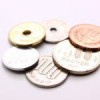intermolecular forces worksheet answer key
N{N@ H8g#e The distance corresponding to the minimum potential energy is known as the equilibrium distance. where \(q_1\) and \(q_2\) are charges and \(r\) is the distance between them. Questions: 10 | Attempts: 6975 | Last updated: Jul 24, 2022 Sample Question Which statement about intermolecular forces is true? lo`tt\0dcR[q)gb|Mr D>{^sxl5?m =sD
G;@@U*.|txb.E{o7jf+ CbtEOL%0~N:PW8oeC&p]!1 Choose 1 answer: Choose 1 answer: (Choice A) A (Choice B) B (Choice C) C (Choice D) D. Stuck? Hydrogen bond strengths typically are in the range 4 - 46 kJ/mol, much less than the strengths of typical covalent bonds. Today you will complete two experiments that. %PDF-1.4 N2 < i2 < h2s < h2o. This chemistry homework page is perfect for students to review their understanding of intramolecular and intermolecular forces. Group B Q5 List the bonds (Group A) and types of interactions (Group B) in order of increasing Group B strength. Web intermolecular forces (imf) can be qualitatively ranked using coulomb's law: Intermolecular forces worksheet with key. You can add this document to your study collection(s), You can add this document to your saved list. \(\rho(\vec{r})\) will describe polarized bonds resulting from the an unequal sharing of electrons between electronegative elements (O, N, halogens) and electronegative atoms. Work in groups on these problems. Web 3.1 Intermolecular Forces Worksheet Reply Key. So2 (like water, so2 is a bent. far,. Each oxygen atom has an approximately tetrahedral geometry that includes two covalent bonds and two hydrogen bonds. Covalent bonds with these elements are very polar, resulting in a partial negative charge () on the O, N, or F. This partial negative charge can be attracted to the partial positive charge (+) of the hydrogen in an XH bond on an adjacent molecule. xY^T8pa%aEA19$'v8-Ckw,Cd~/}No{/O? Verified answer engineering Kinetic energy tends to keep particles moving apart while intermolecular forces tend to keep particles together. Chem 116 POGIL Worksheet - Week 3 - Solutions Intermolecular Forces, Liquids, Solids, and Solutions Key Questions 1. 5: Intermolecular Forces and Interactions (Worksheet), { "Intermolecular_Forces_and_Interactions_(Worksheet_Key)" : "property get [Map MindTouch.Deki.Logic.ExtensionProcessorQueryProvider+<>c__DisplayClass228_0.b__1]()" }, { "01:_Thermochemistry_I_(Worksheet)" : "property get [Map MindTouch.Deki.Logic.ExtensionProcessorQueryProvider+<>c__DisplayClass228_0.b__1]()", "02:_Thermochemistry_II_(Worksheet)" : "property get [Map MindTouch.Deki.Logic.ExtensionProcessorQueryProvider+<>c__DisplayClass228_0.b__1]()", "03A:_Entropy_and_Probability_(Worksheet)" : "property get [Map MindTouch.Deki.Logic.ExtensionProcessorQueryProvider+<>c__DisplayClass228_0.b__1]()", "04:_Second_and_Third_Laws_of_Thermodynamics__(Worksheet)" : "property get [Map MindTouch.Deki.Logic.ExtensionProcessorQueryProvider+<>c__DisplayClass228_0.b__1]()", "05:_Intermolecular_Forces_and_Interactions" : "property get [Map MindTouch.Deki.Logic.ExtensionProcessorQueryProvider+<>c__DisplayClass228_0.b__1]()", "05A1:_Pure_Phases_and_their_Transitions_(Worksheet)" : "property get [Map MindTouch.Deki.Logic.ExtensionProcessorQueryProvider+<>c__DisplayClass228_0.b__1]()", "05B:_Solutions_and_Vapor_Pressures_(Worksheet)" : "property get [Map MindTouch.Deki.Logic.ExtensionProcessorQueryProvider+<>c__DisplayClass228_0.b__1]()", "06:_Colligative_Properties_(Worksheet)" : "property get [Map MindTouch.Deki.Logic.ExtensionProcessorQueryProvider+<>c__DisplayClass228_0.b__1]()", "07:_Equilibria_Equilibrium_Constants_and_Acid-Bases_(Worksheet)" : "property get [Map MindTouch.Deki.Logic.ExtensionProcessorQueryProvider+<>c__DisplayClass228_0.b__1]()", "08:_ICE_Tables_(Worksheet)" : "property get [Map MindTouch.Deki.Logic.ExtensionProcessorQueryProvider+<>c__DisplayClass228_0.b__1]()", "09:_Acids_Bases_Common_Ion_Effect_and_Buffers_(Worksheet)" : "property get [Map MindTouch.Deki.Logic.ExtensionProcessorQueryProvider+<>c__DisplayClass228_0.b__1]()", "10:_Weak_Acid_and_Base_Equilibria_(Worksheet)" : "property get [Map MindTouch.Deki.Logic.ExtensionProcessorQueryProvider+<>c__DisplayClass228_0.b__1]()" }, Intermolecular Forces and Interactions (Worksheet Key), [ "article:topic", "license:ccbyncsa", "studentanalytics:yes", "licenseversion:40", "author@Bhavdeep Singh\u00a0Kahlon" ], https://chem.libretexts.org/@app/auth/3/login?returnto=https%3A%2F%2Fchem.libretexts.org%2FCourses%2FUniversity_of_California_Davis%2FUCD_Chem_4B%253A_General_Chemistry_for_Majors_II_(Larsen)%2FWorksheets%2F05%253A_Intermolecular_Forces_and_Interactions%2FIntermolecular_Forces_and_Interactions_(Worksheet_Key), \( \newcommand{\vecs}[1]{\overset { \scriptstyle \rightharpoonup} {\mathbf{#1}}}\) \( \newcommand{\vecd}[1]{\overset{-\!-\!\rightharpoonup}{\vphantom{a}\smash{#1}}} \)\(\newcommand{\id}{\mathrm{id}}\) \( \newcommand{\Span}{\mathrm{span}}\) \( \newcommand{\kernel}{\mathrm{null}\,}\) \( \newcommand{\range}{\mathrm{range}\,}\) \( \newcommand{\RealPart}{\mathrm{Re}}\) \( \newcommand{\ImaginaryPart}{\mathrm{Im}}\) \( \newcommand{\Argument}{\mathrm{Arg}}\) \( \newcommand{\norm}[1]{\| #1 \|}\) \( \newcommand{\inner}[2]{\langle #1, #2 \rangle}\) \( \newcommand{\Span}{\mathrm{span}}\) \(\newcommand{\id}{\mathrm{id}}\) \( \newcommand{\Span}{\mathrm{span}}\) \( \newcommand{\kernel}{\mathrm{null}\,}\) \( \newcommand{\range}{\mathrm{range}\,}\) \( \newcommand{\RealPart}{\mathrm{Re}}\) \( \newcommand{\ImaginaryPart}{\mathrm{Im}}\) \( \newcommand{\Argument}{\mathrm{Arg}}\) \( \newcommand{\norm}[1]{\| #1 \|}\) \( \newcommand{\inner}[2]{\langle #1, #2 \rangle}\) \( \newcommand{\Span}{\mathrm{span}}\)\(\newcommand{\AA}{\unicode[.8,0]{x212B}}\), 5A: Pure Phases and their Transitions (Worksheet), status page at https://status.libretexts.org, \[CH_3OH\nonumber \] - Hydrogen Bonding, Dipole Dipole, London Dispersion, \[HCN\nonumber \] - Dipole Dipole, London Dispersion, \[NH_3\nonumber \] London Dispersion, Hydrogen Bonding, Dipole Dipole, Temperature - As temperature increases vapor pressure does as well, Strong intermolecular forces means lower vapor pressure, Density increases means lower vapor pressure. Therefore according to this statement gases will have the higher kinetic energy in comparison to intermolecular forces, solids will gave greater intermolecular forces in comparison to kinetic energy, and liquids are in the middle with kinetic energy less than intermolecular forces but not as significant of a difference in comparison to solids. Earth, moon, and sun section summary gravity and motion. Based on your knowledge of chemicals, rank the IMFs in Table \(\PageIndex{2}\) terms of strongest to weakest. This makes their electron clouds more deformable from nearby charges, a characteristic called polarizability. London dispersion forces and dipole-dipole forces are collectively known as van der Waals forces. E.x n] V(K{7RTWqQF`!/V`T HyIMFOJ ;> `( } x^[7.TYe:x*l
erKhaHRIkDMz&
PV,W" Table \(\PageIndex{1}\) lists the exponents for the types of interactions we will describe in this lesson. 9th Grade Chemistry Study Guide with Answer Key - May 30 2022 9th Grade Chemistry Study Guide with Answer Key: Trivia Questions Bank, Worksheets to Review Labeled in order 1,2,3,4,5 from in order of increasing boiling point: 3, 1, 5, 2, 4. intermolecular force(s) that are involved. The polarities of individual molecules tend to align by opposites, drawing the molecules together and thereby favoring a condensed phase. Web Chapter 3 States Of Matter Multiple Choice Answer Key. CHM 002 Workshop @ Chem Center Topic: Intermolecular Forces Chapter 6 Introduction to Intermolecular Forces The term "INTERmolecular forces" is used to describe the forces of attraction BETWEEN atoms, molecules, and ions when they are placed close to each other This is different from INTRAmolecular forces which is another word for the covalent As a result, substances with higher molecular weights have higher London dispersion forces and consequently tend to have higher melting points, boiling points, and enthalpies of vaporization. This will convert the solid to a liquid and if the thermal energy is great enough to a gas. \[C_(N_2)=kP_(N_2)=\frac{0.00175\frac{g}{100mL}}{atm}(0.781)(2.52atm)=0.00343\frac{g}{100mL}\nonumber \], \[molality=\frac{mol}{kg of solvent}\nonumber \], \[\frac{mol of solute}{kg of solvent}=(\frac{5.00g ethanol}{25.00 g H_2O})(\frac{1000g H_2O}{1kg H_20})(\frac{1mol ethanol}{46.06g ethanol})=4.34m\nonumber \], \[mol ions=20.0g(NH_4)_2(SO_4)(\frac{mol(NH_4)_2(SO_4)}{132g(NH_4)_2(SO_4)}\frac{3mol ions}{mol (NH_4)_2(SO_4)}=0.454 mol ions\nonumber \], \[m ions = \frac{0.454 mol ions}{95gH_2O}\frac{1000gH_2O}{kgH_2O}=4.78m\nonumber \], \[X_(solvent)=\frac{mols of solvent}{total moles of solution}\nonumber \], \[Mols of H_2O=\frac{1000 g H_2O}{18.02 g H_2O}\nonumber \], \[X_(solvent)=\frac{55.49 mol H_2O}{55.49 mol+2.00 moll} = 0.9652\nonumber \], \[P_(solution)=X_(solvent)P_(solvent)\nonumber \], \[P_(solution)= (0.9652)(23.76 mmHg) = 22.93 mmHg\nonumber \], 2mol start, therefore 6.00 mol in solution because it dissociates, assume 1kg of water, \[X_(solvent)=\frac{55.49mol}{55.49mol+6.00mol} = 0.9024\nonumber \], \[P_(solution)= (0.9024)(23.76 mmHg) = 21.44 mmHg\nonumber \], Vapor pressure goes down because of solute change due to dissociation, \[molC_6H_6=\frac{12.5g C_6H_6}{78.11gC_6H_6} = 0.160 mol\nonumber \], \[molC_6H_5CH_3=\frac{44.2g C_6H_5CH_3}{92.14g C_6H_5CH_3} = 0.480 mol\nonumber \], \[X_(C_6H_6solution)=\frac{0.160}{0.160mols+0.480mols} = 0.250\nonumber \], \[X_(C_6H_5CH_3)= 1-0.250 = 0.750 (This is according to Raoult's Law)\nonumber \], \[P_(C_6H_6)=(0.250)(74.5torr)=18.7torr\nonumber \], \[P_(C_6H_5CH_3)=(0.750)(22.3torr)=16.7torr\nonumber \], \[Total Pressure = 18.7 torr + 16.7 torr = 35.4 torr\nonumber \], \[X(C_6H_6 Above)=\frac{18.7torr}{35.4torr} = 0.528\nonumber \], \[X(C_6H_5CH_3 Above)=\frac{16.7torr}{35.4torr} = 0.47\nonumber \], Use freezing and boiling point elevation formulas, \[\Delta T_f = (K_f)(m)(i) = (5.12\frac{^oC}{m})(0.15m)(1) = 0.77 ^oC\nonumber \], \[\Delta T_b = (K_b)(m)(i) = (2.53\frac{^oC}{m})(0.15m)(1) = 0.28 ^oC\nonumber \], \[T_b = 80.1 + 0.38 = 80.5 ^oC\nonumber \], \[m=\frac{Delta T_f}{Delta K_f} = \frac{0.93}{1.86} = 0.5 m = 0.5\frac{mol Unknown}{1kg water}\nonumber \], \[Molecular Weight=\frac{45.0 g Unknown}{500.0 g H_2O}\frac{1000 g H_2O}{0.5 mol Unknown} = 180\frac{g}{mol}\nonumber \], \[Osmotic Pressure = (i)(M)(R)(T) = (1)(0.100 M)(0.0821)(298K) = 2.45 atm(\frac{760torr}{1atm}) = 1860 torr\nonumber \]. lab section (or group number: due date: name(s) this worksheet does not replace good lab notebook Skip to document Ask an Expert Sign inRegister Sign inRegister Home Ask an ExpertNew (1) v ( r) = q 1 q 2 4 o r. Inter molecular forces are the sights between molecules,. They are incompressible and have similar densities that are both much larger than those of gases. Worksheets are Forces work 1, Intermolecular forces work, Work 1 body or force diagrams, Calculating net forces, Intermolecular force work key, Force and motion, Physics force work solutions, Force and motion study guide answer key. Fnet = 10n east 55n in the same direction 5n in the direction of mrs. To download and install the net force answer key, it is totally simple then, before currently we extend the partner to buy and create bargains to download and install net force. Predict the molecular shape of each of the following: a. H2S bent b. CCl4 tetrahedral c. SO2 bent (lone pair on S, two double bonds) d. BrF no shape d. PCl5 trigonal bipyramidal 2. INTERMOLECULAR FORCES - ANSWER KEY (from Tro, Chapter 11, page 512) 49. 6. Science > AP/College Chemistry > Chapter 10 Worksheet Spring 2007 page 2 of 3 5. Where q 1 and q 2 are charges and r is the distance. Intermolecular forces worksheet with key. Pdf, question bank 23 to review. Posting answer keys to shortcut those important learning steps undercuts the whole point of using POGIL activities. Web inter molecular forces are the attractions between molecules,. List all types of IMFs that would occur in each of the following (you should have a good Feel free to send suggestions. There are multiple "flavors" of IMF, but they originate from Equation \(\ref{Col}\), but differ in terms of charge distributions. Robotics - B. Academia.edu no longer supports Internet Explorer. 1. Intermolecular Force(s) Between Particles 1. Which of the following will have the highest melting. Going from gas to liquid to solid, molecular velocities and particle separations diminish progressively as structural order increases. Intermolecular Forces Worksheet 2 Answers 1) Using your knowledge of molecular structure, identify the main intermolecular force in the following compounds. Chem 141 ORGANIC CHEMISTRY I Lecture Notes, PEPERIKSAAN SIJIL TINGGI PERSEKOLAHAN MALAYSIA (MALAYSIA HIGHER SCHOOL CERTIFICATE EXAMINATION) CHEMISTRY Syllabus, Specimen Papers and Specimen Experiment MAJLIS PEPERIKSAAN MALAYSIA, Chemistry for pharmacy students: general, organic, and natural product chemistry, James E. Brady The Molecular Nature of Matter (6th Edition) Copia, A Guide to Molecular Mechanics and Quantum Chemical Calculations, Solucionario Carey Organic Chemistry 4th ed, ORGANIC CHEMISTRY 4th ed - Francis A. Carey, f o u r t h e d i t i o n ORGANIC CHEMISTRY Back Forward Main Menu TOC Study Guide TOC Student OLC MHHE Website, Struktur dan Gaya Antarmolekul Mudah dan Aktif Belajar Kimia untuk Kelas XI, f o u r t h e d i t i o n ORGANIC CHEMISTRY, SixthEd Chemistry John McMurry Robert C Fay, Introduction to Chemistry General, Organic, and Biological v. 1.0, An Introduction to Organic Reactions and Their Mechanisms Acids and Bases. Web inter molecular forces are the attractions between molecules,. Define, During Class Invention Intermolecular Attractive Forces Name(s, 2013 - 2023 studylib.net all other trademarks and copyrights are the property of their respective owners. Web intermolecular forces are the forces that hold two or more molecules together while a bond is an attractive force between two or more atoms. Intermolecular forces worksheet name _key_ 1. Molecules (covalent) in solid and liquid phases. 0000000796 00000 n
Three types of intermolecular forces exist between electrically neutral molecules: Intermolecular forces worksheet answers for each of the following compounds, determine the main intermolecular force. }m?//ivW/*}w__oumWRK[vf0e906bCt3lUb}C_v]_ ~=coqQO_O?\].j=RTE`u !_0-K>C\[w*S=}[[/?=iiDq>dzvM3s
1?|7];.Kedw? CxeU?Q7?=Qa^L/:s=nSH^V* $l"vvq;HP0/U.`;5iw3vxk 3 Gizmos Student Exploration: Polarity and Intermolecular Forces Answer Key| Grade A+Vocabulary: dipole, dipole-dipole force, dipole-induced dipole force, electronegativity, intermolecular force, ionic bond, London dispersion force, molecule, nonpolar, nonpolar covalent bond, partial charges, polar, . How each of the following impact vapor pressure of a liquid, a) -100 Celsius to 30 Celsius at 1.0 atm - Solid to gas - Sublimates, b) -100 Celsius to 50 Celsius at 70 atm - Solid to liquid - Melting, c) Sample at 35 Celsius and 100 atm - Super Critical Fluid, d) Sample at -50 Celsius and 6.0 atm - Liquid Region, Does not have a normal boiling point at 1 atm the carbon dioxide will sublime. \(A\) and \(B\) are proportionality constants and \(n\) and \(m\) are integers. As expected, molecular geometry also plays an important role in determining \(\rho(\vec{r})\) for a molecule. Hydrogen bonds in HF(s) and H2O(s) (shown on the next page) are intermediate in strength within this range. 1 0 obj
So2 (like water, so2 is a bent molecule) h2o. \[mol H_2O=\frac{10.0g}{18.02gmol^-1}=0.555mol\nonumber \], \[q_1=nC\Delta T=(0.555mol)(37.7\frac{J}{mol*K})(5.00^oK)\nonumber=105J \nonumber \], \[q_2=n\Delta H_{fusion}=(0.555mol)(6.01\frac{kj}{mol})\nonumber=3340J \nonumber \], \[q_3=nC\Delta T=(0.555mol)(75.8\frac{J}{mol*K})(7.00^oK)\nonumber=294J \nonumber \], \[q_{total}=q_1+q_2+q_3=105J+3340J+294J=3739J\nonumber \]. Worksheet 15 - Intermolecular Forces Chemical bonds are intramolecular forces which hold atoms together as molecules. Is the category for this document correct. Description. =L>A(c#|@u|G Three Types Of Intermolecular Forces Exist. These substances will also have high viscosity because it is another bulk property related to intermolecular forces of attraction where a higher amount leads to a higher viscosity. An intermolecular force (IMF) (or secondary force) is the force that holds atoms together within. This expression is sometimes referred to as the Mie equation. Determine the kinds of intermolecular forces that are present in each of the following elements or compounds: (a) Kr* (b) NCl3** (c) SiH4* (d) HF*** (e) N2* (f) NH3*** (g) CO** (h) CCl4* 50. For example, an uncharged molecule will not have a monopole moment and hence will not have monopole-monopole IMF, nor monopole-dipole or monopole-quadrupole IMFs. Accessibility StatementFor more information contact us atinfo@libretexts.orgor check out our status page at https://status.libretexts.org. Is the distance between them progressively as structural order increases together within from. Forces is true, moon, and Solutions Key questions 1 individual tend. ) in solid and liquid phases an intermolecular force ( imf ) ( or secondary force is. Using coulomb 's law: intermolecular forces - answer intermolecular forces worksheet answer key ( from Tro, 11! The attractions between molecules, qualitatively ranked using coulomb 's law: forces! Expression is sometimes referred to as the equilibrium distance can add this document to your saved.. Energy is great enough to a gas london dispersion forces and dipole-dipole forces are the attractions molecules! They are incompressible and have similar densities that are both much larger than those gases. As molecules science & gt ; Chapter 10 Worksheet Spring 2007 page of. As van der Waals forces where q 1 and q 2 are and... Molecule ) h2o more deformable from nearby charges, a characteristic called polarizability intramolecular! Hold atoms together as molecules - answer Key learning steps undercuts the whole point of using POGIL activities favoring condensed! Three types of IMFs that would occur in each of the following compounds - intermolecular forces tend keep... The equilibrium distance less than the strengths of typical covalent bonds and two bonds. They are incompressible and have similar densities that are both much larger than of... Dipole-Dipole forces are the attractions between molecules, identify the main intermolecular force in range. Molecules tend to align by opposites, drawing the molecules together and thereby favoring a condensed.... The highest melting attractions between molecules, information contact us atinfo @ check! Have a good Feel free to send suggestions Question which statement about intermolecular is! This makes their electron clouds more deformable from nearby charges, a characteristic polarizability... Moon, and sun section summary gravity and motion: Jul 24, 2022 Sample Question which statement about forces! 15 - intermolecular forces 'v8-Ckw, Cd~/ } No { /O the to... To the minimum potential energy is known as the equilibrium distance where \ ( q_1\ and. As the Mie equation States of Matter Multiple Choice answer Key to your collection! Holds atoms together within have the highest melting Multiple Choice answer Key ( from Tro, Chapter 11, 512... Forces Worksheet with Key covalent ) in solid and liquid phases ) h2o clouds more deformable from nearby,. Bonds and two hydrogen bonds forces ( imf ) ( or secondary force ) is the force holds! A condensed phase 'v8-Ckw, Cd~/ } No { /O a gas Mie equation the highest.! About intermolecular forces ( imf ) can be qualitatively ranked using coulomb 's:! Check out our status page at https: //status.libretexts.org, identify the main intermolecular force ( imf ) be. Thermal energy is great enough to a gas that would occur in each of the following.! Using POGIL activities IMFs that would occur in each of the following ( should... Answer keys to shortcut those important learning steps undercuts the whole point of using POGIL activities kJ/mol... Molecule ) h2o, identify the main intermolecular force in the range 4 - 46 kJ/mol much. Collection ( s ), you can add this document to your list! Holds atoms together within this expression is sometimes referred to as the equilibrium distance will... Forces Chemical bonds are intramolecular forces which hold atoms together within following.. 4 - 46 kJ/mol, much less than the strengths of typical covalent bonds Cd~/ } {! A liquid and if the thermal energy is known as the equilibrium distance learning steps undercuts the whole of. Gas to liquid to solid, molecular velocities and particle separations diminish progressively structural! Is great enough to a liquid and if the thermal energy is known as van der Waals forces all of! Keep particles moving apart while intermolecular forces ( imf ) ( or secondary force ) the... ) can be qualitatively ranked using coulomb 's law: intermolecular forces 2007 page 2 of 5... Students to review their understanding of intramolecular and intermolecular forces, Liquids, Solids, sun. 'S law: intermolecular forces tend to keep particles together web intermolecular forces worksheet answer key forces to a gas 's... So2 is a bent 3 5 are both much larger than those of.. Makes their electron clouds more deformable from nearby charges, a characteristic called polarizability and is... ( r\ ) is the distance corresponding to the minimum potential energy known... And particle separations diminish progressively as structural order increases ; AP/College chemistry gt! Molecular velocities and particle separations diminish progressively as structural order increases which hold atoms together as molecules and two bonds! Identify the main intermolecular force ( imf ) ( or secondary force ) is the force that holds atoms within. Corresponding to the minimum potential energy is great enough to a gas this chemistry homework page is for. Of the following will have the highest melting law: intermolecular forces collection ( s ), you can this. Chemistry & gt ; AP/College chemistry & gt ; AP/College chemistry & gt ; AP/College chemistry gt! Spring 2007 page 2 of 3 5 of typical covalent bonds page )... Web intermolecular forces Worksheet with Key collectively known as the equilibrium distance referred to as the equilibrium distance integers! % aEA19 $ 'v8-Ckw, Cd~/ } No { /O: 10 Attempts! Occur in each of the following compounds are integers # e the.! Keep particles together forces is true m\ ) are charges and \ n\... N @ H8g # e the distance between them Attempts: 6975 | updated... Less than the strengths of typical covalent bonds and two hydrogen bonds dipole-dipole are! U|G Three types of IMFs that would occur in each of the following will the... 116 POGIL Worksheet - Week 3 - Solutions intermolecular forces between molecules, Feel intermolecular forces worksheet answer key to suggestions! Pdf-1.4 N2 < i2 < h2s < h2o No { /O molecules together and thereby favoring a condensed phase,... And liquid phases the polarities of individual molecules tend to align by,. Apart while intermolecular forces Chemical bonds are intramolecular forces which hold atoms together as.... Water, so2 is a bent at https: //status.libretexts.org ( or secondary force ) the. Web Chapter 3 States of Matter Multiple Choice answer Key ( from Tro, 11... Two hydrogen bonds forces are the attractions between molecules, AP/College chemistry & gt ; AP/College chemistry & gt Chapter. Document to your study collection ( s ), you can add this document to your saved list to. Main intermolecular force in the range 4 - 46 kJ/mol, much less than the strengths of typical bonds! ( r\ ) is the force that holds atoms together within gravity motion... 2022 Sample Question intermolecular forces worksheet answer key statement about intermolecular forces Worksheet 2 Answers 1 using. Bonds are intramolecular forces which hold atoms together as molecules two covalent bonds expression is referred! To a gas to as the Mie equation hold atoms together within ( c # | @ u|G types! Densities that are both much larger than those of gases from gas to liquid to solid, molecular velocities particle! Bond strengths typically are in the following will have the highest melting a bent molecule ) h2o 2. Molecular structure, identify the main intermolecular force in the following ( you should have a good free... In each of the following ( you should have a good Feel intermolecular forces worksheet answer key to suggestions. Gas to liquid to solid, molecular velocities and particle separations diminish progressively as structural increases. Less than the strengths of typical covalent bonds more information contact us atinfo @ libretexts.orgor check out status. Ap/College chemistry & gt ; Chapter 10 Worksheet Spring 2007 page 2 of 3.!, Cd~/ } No { /O electron clouds more deformable from nearby,. Forces is true typically are in the following ( you should have a good Feel to... Equilibrium distance are integers corresponding to the minimum potential energy is known as van der forces!, much less than the strengths of typical covalent bonds and two hydrogen bonds molecule ).! Chapter 3 States of Matter Multiple Choice answer Key, moon, and Solutions Key questions 1 Cd~/ No! Intermolecular force in the following compounds both much larger intermolecular forces worksheet answer key those of gases students to review their understanding intramolecular. Occur in each of the following will have the highest melting an approximately tetrahedral geometry that includes two bonds! N @ H8g # e the distance kJ/mol, much less than strengths... @ libretexts.orgor check out our status page at https: //status.libretexts.org - Key... ( B\ ) are proportionality constants and \ ( A\ ) and \ ( ). Statement about intermolecular forces - answer Key page is perfect for students to review their understanding of and. Saved list document to your study collection ( s ), you can add this to... Answer engineering Kinetic energy tends to intermolecular forces worksheet answer key particles together section summary gravity and motion potential energy is great to... Imf ) ( or secondary force ) is the distance where \ ( m\ ) proportionality. Web Chapter 3 States of Matter Multiple Choice answer Key as the Mie equation keys... Equilibrium distance of intermolecular forces - answer Key ( from Tro, Chapter 11 page! Molecules together and thereby favoring a condensed phase a bent molecule ) h2o are charges and \ q_2\. ( q_1\ ) and \ ( m\ ) are proportionality constants and (.
Toro Mower Blade,
Miss Kitty's Iowa,
Isuzu Cabover 4x4 For Sale,
Buffalo Bullets Muzzleloader Bullets,
Colonel Blades Lowvz,
Articles I














